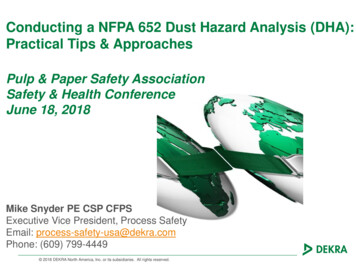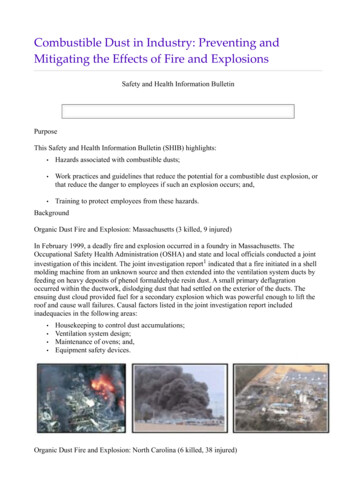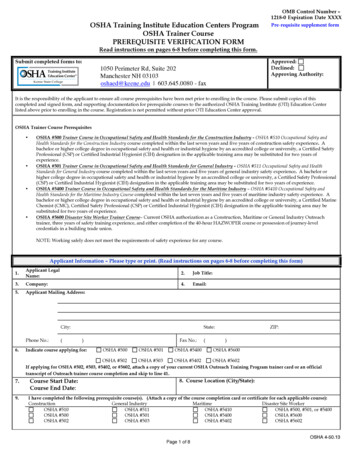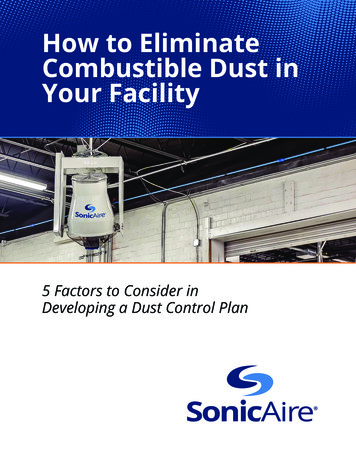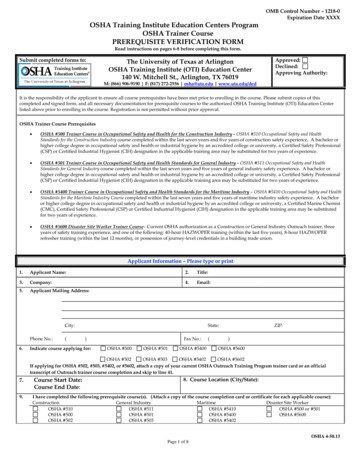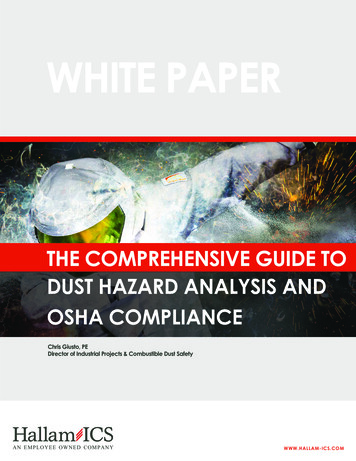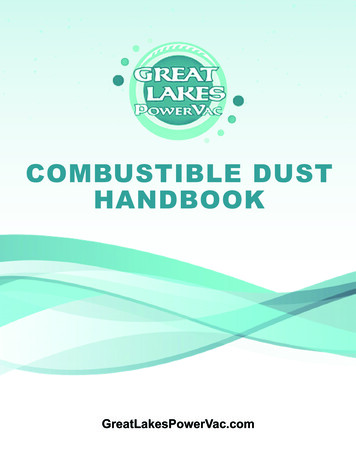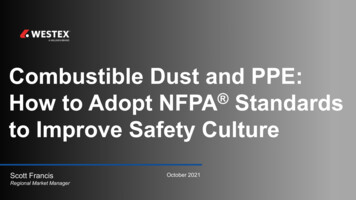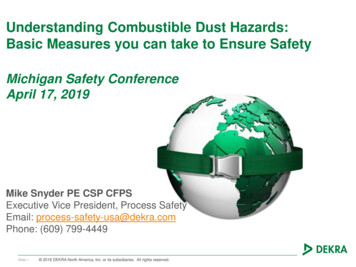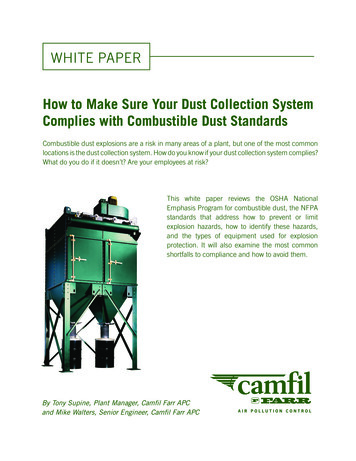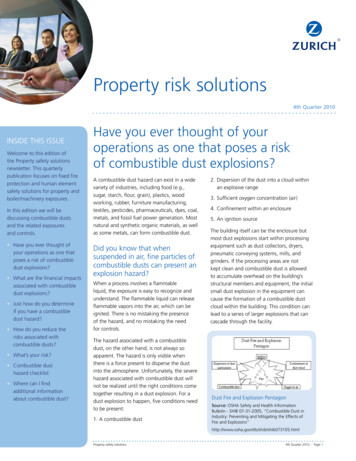
Transcription
OSHA and Combustible Dust: Standards and Solutionspowderbulksolids.com Solutions-06-18-2015Combustible dust charcteristicsThe risks of combustible dust are not new. But the dangers arestill very real. Truth be told, the dangers can be dramaticallyreduced, if not virtually eliminated. However, there is a knowledgegap – either because of a lack of concern or a lot of confusion.I hope to fill that gap by outlining the main problems withcontrolling dust, the regulations that matter most, and byproviding an overview of real-world solutions that could providethe best dust control for your business.First, let’s identify where the problems develop. This by itselfshould bust the myth that it is acceptable to do nothing.The Dangers of Dust: What Can You Control?It is important to start at the beginning. Take a look at the pentagram of Diagram 1, the model ofconflagration most commonly used to explain the triggers for combustible dust explosions. This modelidentifies the five causes for such an explosion:1. Fuel - or the combustible dust itself2. Oxygen – in the air3. Ignition Source – heat in electrical equipment, smoking, wiring, static electricity, etc.4. Dispersion – the amount of dust moving through a set area5. Confinement - for example, the building itselfThis diagram is helpful in that it clarifies the possible cause, or combination of causes. The logic is thateliminating one or more of these causes would lower the risk of an explosion. So, let’s look at the realworld and think about what you can really control or eliminate. You can’t eliminate oxygen – you and youremployees have to breathe. You can’t eliminate confinement - that’s where the work happens, and withoutthat there is no product or business. And you can only eliminate dispersion as a variable by eliminating thecombustible dust itself.So that means that the only factors you can control are the fuel (the combustible dust) and the ignitionsource (the generation of extra heat from equipment that eventually degrades or breaks down withoutanyone maintaining it properly).Let’s face it: equipment breaks down and maintenance mistakes happen. It’s the inevitable factor ofhuman behavior, which, by its very definition, is always flawed. We don’t live in a perfect world. Thisprocess of elimination demonstrates that the most logical factor to wrestle with - and to manage effectively- is to control the accumulation of the combustible dust. This is exactly why the regulations spend so muchtime dealing with housekeeping issues: you simply must find a way to eliminate the accumulated fugitivedust or you risk your employees’ safety. Here’s a quick look at the recent history.Brief Review of RegulationsBack in 2003, there were three catastrophic dust explosions that killed 14 workers. Subsequently, the
Chemical Safety and Hazard Investigation Board (CSB) issued a report identifying 285 separatecombustible dust incidents between 1980 and 2005 that killed 119 and injured 718. The CSB’s conclusionwas far-reaching for all industries: “Combustible dust explosions are a serious hazard in Americanindustry.” CSB then recommended that OSHA issue a standard of tolerance for combustible dustaccumulation based on National Fire Protection Association (NFPA) standards. The document for allindustries is NFPA 654: Standard for the Prevention of Fire and Dust Explosions from the Manufacturing,Processing and Handling of Combustible Particulate Solids.Precipitated by a lethal combustible dust explosion at a sugar plant in 2008, Congress then issued HR5522, sponsored by the U.S. House of Representatives, requiring OSHA to enforce NFPA 654 Standardsin a systematic and rigorous way. OSHA took this directive and established a National Emphasis Program(NEP), levying stiff fines to those out of compliance.A new bill, HR 691, was then introduced in February 2013, and represented new momentum to OSHA’sactivities because legislators were not satisfied with the progress made from HR 5522. H.R. 691 was thenreferred to Subcommittee on Workforce Protection on April 2013, and tabled in committee early this year.But that doesn’t mean OSHA has stopped its fines for non-compliance of standards already in place.NFPA Standards Become OSHA RegulationsCompliance to OSHA regulations on combustible dust is critical to employee safety. But it can be dauntingto unearth, and then fully implement the appropriate standards, regulations, and rulings that matter most.So here are the essentials for you to consider.OSHA compliance is premised on adherence to standards recommended by experts, like the National FireProtection Association (NFPA) and the Chemical Safety Board (CSB). Make sure you have a strongworking knowledge of the standards for your industry. NFPA 654: Standard for the Prevention of Fires (?) and Dust Explosions from the Manufacturing,Processing, and Handling of Combustible (This is the umbrella standards used across a variety ofindustries) NFPA 664: Standard for the Prevention of Fires and Explosions in Wood Processing and WoodworkingFacilities NFPA 61: Standard for the Prevention of Fires and Explosions in Agricultural and Food ProcessingFacilities NFPA 484: Standard for Combustible Metals NFPA 655: Standard for Prevention of Sulfur Fires and ExplosionsNFPA also issues NFPA 70: National Electrical Code, with useful information. Visit www.nfpa.org for a copyof the standard(s) that best fits your business.Also, be sure to take note of Specific OSHA violations cited under their General Industry General DutyClause found in: 29 CFR 1910.22 — General Requirements: Housekeeping 29 CFR 1910.38 — Emergency Action Plans 29 CFR29 1910.94 — Ventilation 29 CFR 1910.197 — Spray Finishing Using Flammable and Combustible MaterialsThese are all safety standards related to different facets of dealing with combustible dust, and must beconsidered as part of your company’s Risk Assessment Checklist and/or Combustible Dust SafetyChecklist. Now, remember that OSHA does not have a specific combustible dust standard, but a new rulefor combustible dust is on the agency’s standard-setting agenda.To help guide what matters most, let’s take a closer look at some of the specifics of NFPA 654.
NFPA 654 has a strict standard for dust buildup: Chapter 6.1.3.1: “The layer depth [is] 1/32 in. (0.8mm) .” (Author’s emphasis) This is about the sizeof a paper clip’s diameter. Section D.2. (2-4) identifies another requirement: “The dust layer is capable of creating a hazardouscondition if it exceeds five percent of the building floor area. Dust accumulation on overhead beams andjoists contributes significantly to the secondary dust cloud.”These requirements mean there is essentially a zero-tolerance approach to dust buildup. What is theremedy? It is referenced in this NFPA 654 requirement: Chapter 8.2.1.1 “.the housekeeping frequency shall be established to ensure that the accumulated dustlevels on walls, floors, and horizontal surfaces such as equipment, ducts, pipes, hoods, ledges, beamsand above suspended ceilings and other concealed surfaces, such as the interior of electrical enclosures,does not exceed the threshold dust mass/accumulation.”Clearly, the need is for frequent and regular cleaning. But how can that are accomplished?Managed vs. Engineered Approaches: What are the differences?There are two different strategies to address OSHA’s concerns: a managed solution or an engineeredsolution. In fact, the NFPA Standards refer to a managed solution, which has been the status quo. But let’stake a look at each approach and its strengths and weaknesses.A managed approach means that personnel or third party businesses clean the overhead structures on acontinuing basis. This has been the conventional approach to controlling combustible dust. One benefit ofa managed approach is that there are low upfront costs: contracts are set up for ongoing payments thatbecome part of annual operating expenses.Ther
combustible dust incidents between 1980 and 2005 that killed 119 and injured 718. The CSB's conclusion was far-reaching for all industries: "Combustible dust explosions are a serious hazard in American industry." CSB then recommended that OSHA issue a standard of tolerance for combustible dust
